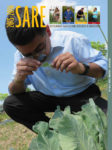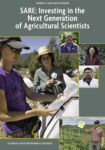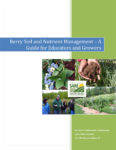Showing 31-40 of 71 results
Managing Cover Crops for Ecosystem Services in Vegetable Systems
Natalie Lounsbury (University of New Hampshire) discusses how to manage cover crops for such ecosystem services as: suppressing weeds, attracting pollinators, cycling nutrients, promoting biological diversity and controlling erosion.
Overview of Cover Crop Developments Nationwide
Rob Myers (North Central SARE, University of Missouri) provides a national overview of where cover crops stand, including a review of farmer survey data, new equipment and proposed initiatives.
Fitting Cover Crops in Vegetable Rotations
Ron Morse (Virginia Tech, emeritus) shares how to successfully fit cover crops into a vegetable rotation, including establishment methods, matching the right species to the right methods, recommended rotations and cash crop establishment.
Establishment Methods for Cover Crops and Cash Crops in Grain Production Systems
Steven Mirsky (USDA-ARS), Greg Roth (Penn State University) and Sjoerd Duiker (Penn State University) discuss common establishment methods for cover crops; the importance of matching the right cover crop species with the right methods; and other topics such as no-till versus tillage; optimal timing of cash crop establishment, drills versus planters, planter and drill attachments and set up; cover crop termination; and planting green.
Cover Crop Cocktails
Mitch Hunter (Penn State University) discusses the principles of how to assemble different cover crop species into a successful cocktail based on farm management objectives, crop rotation restraints, and which cover crop species traits are complementary.

2015/2016 Report from the Field
Read about SARE-funded work in the areas of sustainable dairy cropping systems, soil health assessments, nutrient management, cover crops, beginning farmers, pollinators, technical assistance programs for women farmers, and more. This edition includes highlights of projects funded through the graduate student program, and the highly regarded Sustainable Agriculture Fellowship, a professional development program coordinated by SARE and NACAA.

Investing in the Next Generation of Agricultural Scientists
Sustainable solutions to today's agricultural challenges arise when scientists, educators and producers work together to test theories in real-world, on-farm situations. For this approach itself to be sustainable, there must be opportunities for the next generation of agricultural scientists to use collaborative, applied research to address the real-world needs of farmers and ranchers. The SARE Graduate Student grant program is one such opportunity—since 2000, the program has supported the work of 600 master's and Ph.D. students.

Cover Crops for Soil Health Workshop
All session recordings and slide presentations from this three-day professional development workshop are available online. Hosted by Northeast SARE and Delaware State University in March 2016, this event addressed the latest research on the benefits and successful management of cover crops in grain, vegetable and animal production systems.

Cover Crop Innovators Video Series
Find short video profiles of farmers around the country who are using cover crops on their land.

Berry Soil and Nutrient Management Guide for Educators and Growers
This manual has been designed as a comprehensive guide for educators and commercial berry growers interested in improving berry crop soil and nutrient management.